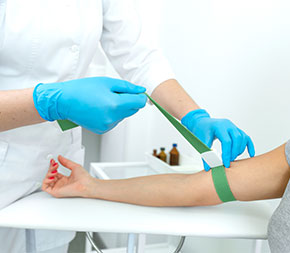Getting The Northeast Medical Institute - New Haven Campus Phlebotomy Course & Cna Class To Work
Wiki Article
The 10-Second Trick For Northeast Medical Institute - New Haven Campus Phlebotomy Course & Cna Class
Table of ContentsThe Main Principles Of Northeast Medical Institute - New Haven Campus Phlebotomy Course & Cna Class The 7-Second Trick For Northeast Medical Institute - New Haven Campus Phlebotomy Course & Cna ClassHow Northeast Medical Institute - New Haven Campus Phlebotomy Course & Cna Class can Save You Time, Stress, and Money.The Ultimate Guide To Northeast Medical Institute - New Haven Campus Phlebotomy Course & Cna ClassNortheast Medical Institute - New Haven Campus Phlebotomy Course & Cna Class Fundamentals ExplainedGetting The Northeast Medical Institute - New Haven Campus Phlebotomy Course & Cna Class To Work
The usage of such gadgets must be gone along with by other infection prevention and control techniques, and training in their use. Not all safety tools apply to phlebotomy. Prior to choosing a safety-engineered gadget, users should extensively explore readily available gadgets to identify their appropriate usage, compatibility with existing phlebotomy techniques, and effectiveness in securing personnel and people (12, 33).For settings with low sources, expense is a driving consider purchase of safety-engineered tools - CNA Classes. Where safety-engineered tools are not offered, experienced usage of a needle and syringe serves. Unintended direct exposure and details details regarding an incident should be recorded in a register. Assistance services should be advertised for those who undertake unintentional direct exposure.
In the blood-sampling area for an outpatient division or clinic, provide a comfortable reclining sofa with an arm remainder.
7 Easy Facts About Northeast Medical Institute - New Haven Campus Phlebotomy Course & Cna Class Shown
Make sure that the indicators for blood tasting are clearly specified, either in a written procedure or in recorded instructions (e.g. in a research laboratory kind). Whatsoever times, comply with the strategies for infection avoidance and control noted in Table 2.2. Infection avoidance and control methods. Collect all the equipment needed for the procedure and place it within safe and very easy reach on a tray or trolley, making certain that all the products are clearly visible.Introduce yourself to the client, and ask the client to mention their complete name. Examine that the laboratory form matches the client's identity (i.e. match the individual's information with the research laboratory form, to guarantee precise recognition).
Make the patient comfy in a supine position (if possible). Place a tidy paper or towel under the client's arm. Go over the examination to be done (see Annex F) and get spoken approval. The client has a right to refuse a test any time prior to the blood tasting, so it is very important to make certain that the individual has actually comprehended the procedure.
Northeast Medical Institute - New Haven Campus Phlebotomy Course & Cna Class for Dummies
Extend the individual's arm and check the antecubital fossa or forearm. Find a capillary of a great size that shows up, straight and clear. The representation in Section 2.3, shows usual settings of the vessels, yet numerous variations are feasible. The median cubital capillary exists in between muscles and is normally the most simple to penetrate.DO NOT place the needle where veins are diverting, since this enhances the possibility of a haematoma. The capillary needs to be visible without applying the tourniquet. Locating the vein will help in determining the correct size of needle. Use the tourniquet about 45 finger widths above the venepuncture site and re-examine the blood vessel.
Haemolysis, contamination and existence of intravenous liquid and medication can all alter the results (39. Nursing staff and physicians may access main venous lines for samplings complying with procedures. Specimens from main lines carry a threat of contamination or incorrect laboratory examination results. It is appropriate, however not ideal, to injure specimens when initial introducing an in-dwelling venous tool, before connecting the cannula to the intravenous fluids.
Indicators on Northeast Medical Institute - New Haven Campus Phlebotomy Course & Cna Class You Need To Know
Failure to permit adequate call time increases the risk of contamination. DO NOT touch the cleaned site; in particular, DO NOT place a finger over the blood vessel to direct the shaft of the subjected needle.Ask the client to form a fist so the veins are more prominent. Get in the blood vessel quickly at a 30 degree angle or less, and continue to present the needle along the blood vessel at the most convenient angle of entry - Phlebotomy Courses. When sufficient blood has been collected, launch the tourniquet BEFORE withdrawing the needle
Northeast Medical Institute - New Haven Campus Phlebotomy Course & Cna Class Fundamentals Explained
Take out the needle gently and apply gentle pressure to the site with a clean gauze or completely dry cotton-wool sphere. Ask the person to hold the gauze or cotton woollen in position, with the arm extended and increased. Ask the person NOT to flex the arm, because doing so creates a haematoma.
Northeast Medical Institute - New Haven Campus Phlebotomy Course & Cna Class for Beginners
Where feasible, keep the tubes in a rack and relocate the rack in the direction of you - https://northeastmed.carrd.co. If the example tube does not have a rubber stopper, infuse extremely gradually into the tube as minimizing the pressure and rate used to transfer the specimen reduces the threat of haemolysis.
Report this wiki page